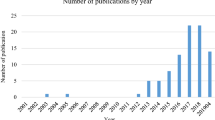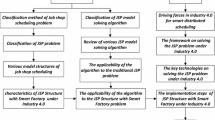Abstract
A recurrent problem in discrete parts manufacturing is to select the optimal mix of parts and to allocate the necessary tools on a machine's carousel in order to maximize net profit. We formulate the problem as an integer program and compute an upper bound for the optimal solution. We then develop a greedy type heuristic to obtain a lower bound on the value of the optimal solution. Further, we show that the worst case relative error of the proposed heuristic approaches 1y2. Finally, we demonstrate via extensive computational experimentation that the greedy heuristic produces near optimal solutions for a variety of problem instances.
Similar content being viewed by others
References
J.F. Bard, A heuristic for minimizing the number of tool switches on a flexible machine, IIE Transactions 20(1988)382 - 391.
J.F. Bard and T.A. Feo, Operations sequencing in discrete parts manufacturing, Management Science 35(1989)249 - 255.
M. Cornuejols, M.L. Fisher and G.L. Nemhauser, Location of bank accounts to optimize float: An analytic study of exact and approximate algorithms, Management Science 23(1977)789 - 810.
A.M. Geoffrion, Lagrangian relaxation for integer programming, Mathematical Programming Study 2(1974)82 - 114.
W.W. Gilbert, Economics of machining, in: Machining Theory and Practice, American Society for Metals, Cleveland, OH, 1950.
A.E. Gray, A. Seidmann and K.E. Stecke, A synthesis of decision models for tool management in automated manufacturing, Management Science 39(1993)549 - 567.
V.N. Hsu, M. Daskin, P.C. Jones and T.J. Lowe, Tool selection for optimal part production: A Lagrangian relaxation approach, IIE Transaction 27(1995)417 - 426.
C. Koulamas, Design of tool magazine and operational areas for a multi-tool machine, European Journal of Operational Research 63(1992)240 - 253.
S. Martello and P. Toth, Knapsack Problems: Algorithms and Computer Implementations, Wiley, New York, 1990.
S.C. Sarin and C.S. Chen, The machine loading and tool allocation problem in a flexible manufacturing system, International Journal of Production Research 25(1987)1081 - 1094.
P.J. Schweitzer and A. Seidmann, Optimizing processing rates for flexible manufacturing systems, Management Science 37(1991)454 - 466.
K.E. Stecke, Formulation and solution of nonlinear integer production planning problems for flexible manufacturing systems, Management Science 29(1983)273 - 288.
C.S. Tang and E.V. Denardo, Models arising from a flexible manufacturing machine, Part I: Minimization of the number of tool switches, Operations Research 36(1988)767 - 777.
C.S. Tang and E.V. Denardo, Models arising from a flexible manufacturing machine, Part II: Minimization of the number of tool switching instances, Operations Research 36(1988)778 - 784.
D. Thomas, Automatic tool changing, Proceedings of the 2nd International Conference on Flexible Manufacturing Systems, London, UK, North-Holland, Amsterdam, 1983, pp. 431 - 450.
P. Tomek, Tooling strategies related to FMS management, The FMS Magazine 5(1986)102 - 107.
Rights and permissions
About this article
Cite this article
Iakovou, E., Koulamas, C. & Malik, K. Part selection and tool allocation in discrete parts manufacturing. Annals of Operations Research 76, 187–200 (1998). https://doi.org/10.1023/A:1018940420058
Issue Date:
DOI: https://doi.org/10.1023/A:1018940420058




